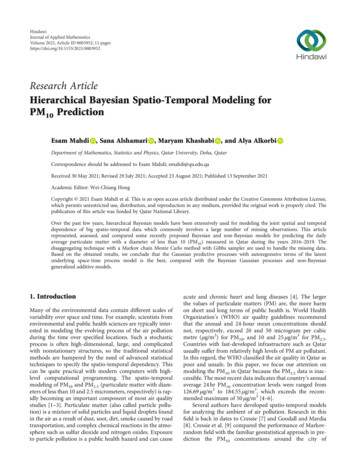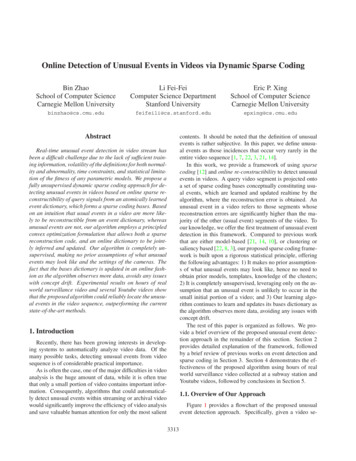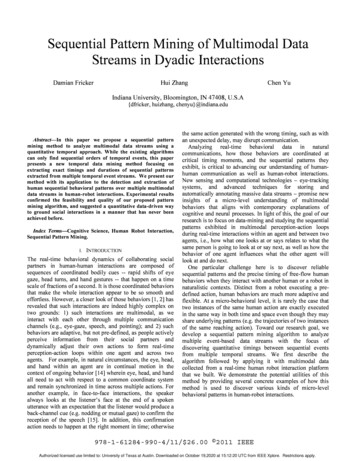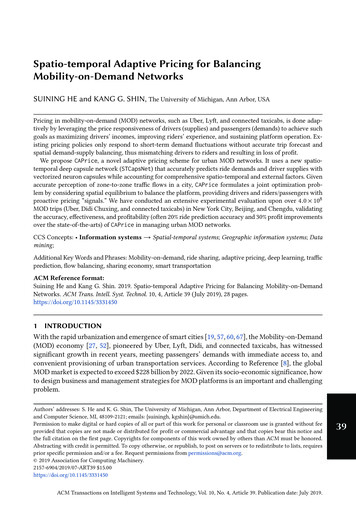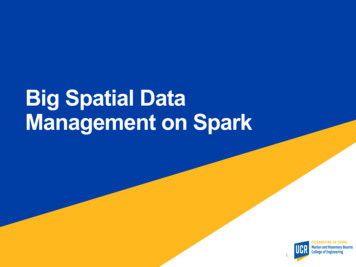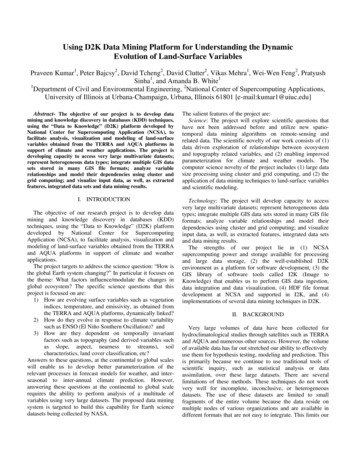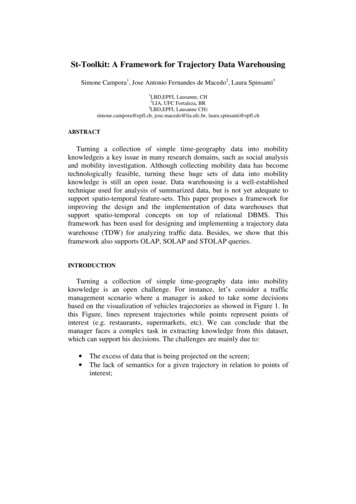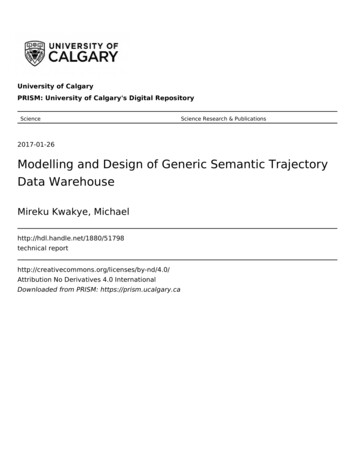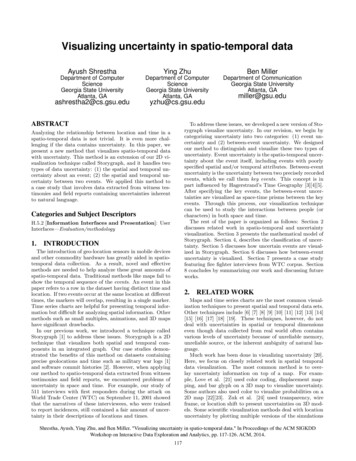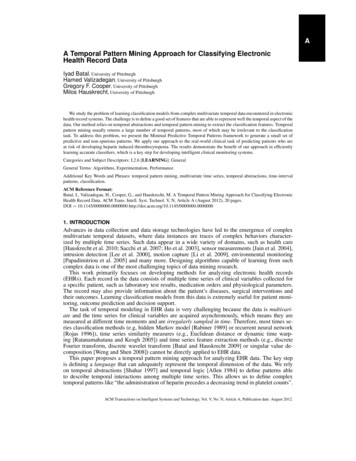
Transcription
APPLICATIONS OF SPATIO-TEMPORAL DATA MINING AND KNOWLEDGEDISCOVERY (STDMKD) FOR FOREST FIRE PREVENTIONT. ChengJ. WangSchool of Geography and Urban PlanningSun Yat-sun University, Guangzhou, P R Chinatao tao815@hotmail.comcafes123@163.comKEYWORDS: Data Mining and Knowledge discovery, Spatio-Temporal Data Mining, Forest Fire Prevention, Artificial NeuralNetworkABSTRACT:Forests play an important role for sustaining the natural environment of human living. Forest fires not only destroy naturalenvironment and ecological equivalence, but also threaten security of life and wealth to people. This paper presents applications ofSpatio-temporal Data Mining and Knowledge Discovering (STDMKD) for forest fire prevention. The special attention of theresearch is paid to the spatio-temporal forecasting of forest fires because of the importance of prediction for the fire prevention. It isalso due to the fact that most existing spatio-temporal forecasting methods cannot handle the dynamic development of forest firesover space. An improved spatio-temporal integrated forecasting framework – ISTIFF is proposed. The method and algorithm ofISTIFF are presented, which are illustrated by a case study of forest fire area predication in Canada. Comparative analysis of ISTIFFwith other methods is implemented, which shows its high accuracy in short-term prediction. Based upon the forecasting result, moreintelligent strategies of fire prevention and extinguishments can be delivered to decision makers in fireproofing.1. INTRODCUTIONForests play an important role for sustaining the naturalenvironment people live in. Because forest fires are among thebest dangers for forest prevention, it is not a surprise to seeincreasing expenditures for forest fire control. Even so, millionsof hectares of forests are still destroyed by fires every yeararound the world. That this number has not declined impliesthat controlling fires is a complex task, and indeed forest firescan become as large as 600 km2 within 9 days and cost millionsof dollars to extinguish (Martinus and Junk, 1982). Althoughmost fires are extinguished quickly, a few forest fires becomeuncontrollable for human intervention after which they causehuge damages to the environment and endanger human lives.For example, Victoria (Australia) fire disaster in 1983, burned392 000 ha of (grass) land and killed 75 people (Moore andTrevitt, 1991). Therefore, discovering and forecasting forest fireas early as possible is an urgent requirement for forest fireprevention.In China, forests are a very rare natural resource. Forest fireshappen frequently and the loss is very serious each year. It notonly destroys natural environment and ecological equivalence,but also directly influences the production of industry andagriculture, and seriously threatens security of life and wealth topeople (Zhang, 2004). In order to predict, detect and controlforest fire, forest fire prevention information system is urgentlyneeded. In 2002, the National Bureau of Forestry of China hasinvested twenty millions of RMB in building such forest fireprevention information system. The system plays a veryimportant role in forest fire detection and fire extinguishing.To build the forest fire prevention information system, not onlychina, but also other countries such as Canada have built databases to record forest fires and relevant weather information,which accumulates huge spatio-temporal data. Due to the lackof platform and tools to mine spatio-temporal data, it is difficultto adequately make use of the data for forest fire prevention.Therefore, advanced techniques of spatio-temporal data analysisand data mining should be applied to extract implicit knowledge,spatial and temporal relationships or other patterns not explicitlystored in the system, in order to enhance the intelligence ofsystems and to facilitate decision-making.In the following sections, we first introduce spatio-temporaldata mining techniques for forest fire prevention. Then wepresent a spatio-temporal forecasting approach, an improvedspatio-temporal forecasting framework (ISTIFF) for dynamicprocess changing over space (such as forest fire). Finally, wecarry out forest fire area forecasting in Alberta of Canada byusing the proposed approach. It is shown in our case study thatISTIFF has high accuracy for dynamic forecasting, whichprovides a very useful tool for forest fire forecasting.2. SPATIO-TEMPORAL DATA MINING TECHNIQUESFOR FOREST FIRE PREVENTIONSpatio-temporal data mining is the extraction of unknown andimplicit knowledge, structures, spatio-temporal relationships, orpatterns not explicitly stored in spatio-temporal databases (Yao,2003). Spatio-temporal data mining techniques and tasksinclude spatio-temporal forecast and trend analysis, spatiotemporal association rule mining, spatio-temporal sequentialpatterns mining, spatio-temporal clustering and classificationand so on. Difficulty of spatio-temporal data mining relies onhow to integrate space and time seamlessly and simultaneously.The techniques of spatio-temporal mining can be applied forforest fire prevention as follows.1) Spatio-Temporal Forecasting and Trend AnalysisSpatio-temporal forecasting and trend analysis technique is aneffective means of forecasting spatial attribute. Spatio-temporalforecasting has been developed from individual spatial ortemporal forecasting and gained heavy attention for itspromising performance in handling complex data in which notonly spatial but also temporal characteristics must be taken intoaccount. The key issue is to integrate space and time. Some
mature analysis tools, e.g., time series or spatial statistics areextended to spatio-temporal problem.“Forest fire always occurs at region R1 prior to the occurrenceof haze in nearby region R2.”Based upon the information of the forest fires in the past, we areable to predict the forest fires in future, so as to facilitate the fireprevention. Spatio-temporal forecasting and trend analysistechnique can predicate the speed of fire spreading, the trend offire spreading, the area and length of fire field, so as to providereal time optimised fighting plan to minimize the total cost dueto the fire.4) Spatio-Temporal Cluster Characteristic and DiscriminateRule Mining2) Spatio-temporal Association Rule MiningAssociation Rule Mining has been one of the most extensivelystudied data mining techniques. A spatio-temporal associationrule is an implication of strong association between A and Bwith the form A B, where A and B are sets of spatiotemporal and non-spatio-temporal attributes. The implicationcarries the meaning that if the attributes at A take some specificvalue at a point in time, then with a certain probability, at thesame point in time, the attributes at B will take some specificvalue (Gidofalvi, 2004). A spatio-temporal association rulemight find that “If forest fire has been found at A at a specifictime, at the meanwhile, it might be quite possible that fire willoccur at B.”Despite the abundance of spatio-temporal data, the number ofalgorithms that mine such data is few. The main reason for thelack of efficient algorithms is due to the exponential explosionin the search space for knowledge caused by the added spatialand temporal attributes. Existing attempts is to modify classicalrule mining method to spatio-temporal association rule, thuslosing the spatio-temporal characteristics (Verhein and Chawla,2005).Spatio-temporal association rule technique might be able toidentify the relationship of locations A with B over time changebetween weather conditions (wind speed, wind direction,temperature, humidity), forest fuel type, and geographicalconditions (degree of slope, aspect of slope, position of slope).3) Spatio-temporal Sequential Patterns MiningThe task of mining spatio-temporal patterns is to find outsequences of events (an ordered list of item sets) that occurfrequently in spatio-temporal datasets. A spatio-temporalsequential pattern has the form A B, where A and B aresets of spatio-temporal and non-spatio-temporal attributes,meaning that if at some point in time and space, the attributes inA take some specific value, then with a certain probability atsome later point in time, attributes in B will take some specificvalue (Gidofalvi, 2004). A spatio-temporal sequential patternmight be that “If forest fire has been found at A, it might bequite possible that fire will occur at B in two hours at certainweather condition”.The sequential pattern mining algorithms were first introducedby Agrawal and Srikant in 1995 (Agrawal and Srikant, 1995).Six years later, Tsoukatos and Gunopulos extended thesemethods by adding spatial dimension. An efficient DFS (DepthFirst Searching) algorithm was proposed to discover spatiotemporal sequential patterns for weather prediction.By spatio-temporal sequential patterns mining technique wemay discovery a spatio-temporal sequential pattern that tells,Cluster characteristic or discriminate rules associate objectsbelonging to a cluster of some attributes with some probability.A spatio-temporal clustering might discover that “The gridcells with similar values in meteorological satellite image atnoon, can be clustered as a spot at high temperature, tending tobe a fire spot”. Widely used spatial clustering techniques e.g.,K-means and K-medoids and CLARANS (Han and Kamber,2001), may be extended for spatio-temporal clustering.In addition to discriminate the fire spot, spatio-temporal clustercharacteristic and discriminate mining technique might be ableto classify the fire risk ranking and predict the probability offorest fire.3. SPATIO-TEMPORAL FORECASTING OF FORESTFIRE AREA3.1 PrincipleAs one of data mining techniques, forecasting is widely used topredict the unknown future based upon the patterns hidden inthe current and past data. Due to the increasing demand forspatio-temporal data mining in many application fields, manyspatio-temporal forecasting models are pproposed. Theseforecasting models are based on mature analysis tools, e.g., timeseries or spatial statistics, which are extend to spatial ortemporal aspect, respectively. For example, spatial statisticsconcepts were extended to take the time dimension into accountin (Cressie, and Majure, 1997; Pokrajac and Obradovic, 2001).On the contrary, Deutsch et al. incorporated spatial correlationinto the multivariate time series analysis with the help of aneighboring distance matrix (Deutsch and Ramos, 1986; Pfeifer,and Deutsch, 1990).Recently, Li and Dunham proposed a spatio-temporal integratedframework - STIFF, which is applied to forecast the water flowrate at gauging station in the catchment (Li and Dunham, 2002).In STIFF, time series analysis strategy is incorporated to capturethe temporal correlations and the artificial neural networktechnique is employed to discover the hidden and deeplyentangled spatial relationships, then the two mechanisms arecombined via regression to generate the overall forecasting. Itovercomes deficiency of previous works by loosening theirstringent assumptions and excessive simplification.However, STIFF approach is insufficient in forecasting forestfire because forest fire is a dynamic process developing overspace, which cannot be handled by a static forward neuralnetwork based on BP algorithm that STIFF employed. Elman isa kind of dynamic recurrent neural network (RNN). Thisrecurrent connection allows the network to both detect andgenerate time-varying patterns as well as spatial-varyingpatterns. Because the network can store information for futurereference, it is able to learn temporal patterns as well as spatialpatterns. Therefore, we use Elman network to produce spatialforecasting. To differentiate from STIFF, we call our approachas ISTIFF, i.e. improved STIFF, due to its improved ability ofdetecting spatial-varying patterns and the improved accuracy offorecasting.
The key idea of spatio-temporal forecasting is as follows:constructing a stochastic time series models to capture thetemporal characteristics of each spatially independentsubcomponent, then building an dynamic recurrent neuralnetwork (RNN) to discover the hidden spatial correlation,finally combining the previous individual temporal and spatialforecasts based upon statistical regression to procure the finalforecasting result.statistical regression mechanism, to generate the finalspatio-temporal forecast.The detailed implementation of the algorithm is illustrated inthe next section. The novelty in our approach lies at Step 3, i.e.a dynamic recurrent neural network is applied (please refer toSection 4.2 for detailed implementation), which overcomes theshortcomings in STIFF.3.2 Problem Definition4. CASE STUDYThe spatio-temporal forecasting can be formally defined asfollows:1. The research area Δ is composed of n 1 subcomponentsdenoted by α 0,α1, K, α n , which can be spatially separated fromeach other. Without loss of generality, α 0 is assumed to be theonly target subcomponent where the spatio-temporal forecastingwill be conducted.2. For each α i Δ , there are j time series observationsα i1,α i 2, K, α ij , that are recorded as i for convenience.3. Given the collection of subcomponents Δ {α 0,α1, K, α n } ,the whole available dataset { 0, 1, K, n } and the look-ahead steps of s , the problem asks to find a mappingrelationship f , defined asf : {Δ, Π , l , s} f {σ 0(l 1),σ 0(l 2),L,σ 0(l s ), }which should be as precise as possible, whereA practical spatio-temporal forecasting is presented to explainthe novel approach discussed in the previous section and toshow how accurate the overall forecasting could be.The case study is based upon the data kindly provided by CFS(Canada Forest Service) (CFS). LFDB (Canada Large FireDatabase) records large forest fires of which areas exceed twohundred hektare from 1959 to 1999 and covers every province,region and forest park in Canada. Spatial relationship is given inFigure 1 for the study area. Alberta (AB) province is where theforecasting will be carried out. In other words, it is the targetlocation a0 in term of the problem definition. We are going toforecast the area (ha3/month/year) at Alberta (AB), the targetsubcomponent. The neighbouring (spatially correlated)provinces, the non-target subcomponents, are British Columbia(BC), Saskatchewan (SK), Manitoba (MB), Ontario (ON),Northwest Territories (NWT) and Quebec (QC).(1)l ( ai ), σ i j(i 0, 1, , n; j 0, 1, , l) is the jth observation in time seriesdataσi .NorthwestTerritories3.3 AlgorithmAlbertaThe problem defined above can be solved by the algorithm withthe following steps:ManitobaSaskatchewanOntarioQuebecSetp 1: Define the forecasting problem in terms of thespecification by determining the target subcomponent α 0and its spatially-correlated siblings α1,α 2, K, α n .Setp2: For each subcomponent α i Δ build a time seriesmodel TSi that will implement the needed temporalforecasting for each subcomponent. Specifically, temporalforecasting for the target subcomponent α 0 is denoted asFigure 1 Spatial Distribution of Provinces in CanadafT instead of TS0 to differentiate from othersubcomponents.Setp3: Based upon the spatial correlation of all non-targetsubcomponents α i (i 1,., n) , an artificial neural networkFist of all, original data is analysed and we find some missingvalue in original data. After determining the integrality of data,we choose data between 01/1959 and 12/1988 as the training toforecast the data between 01/1989 and 12/1999. A fraction plotof time series data between 01/1959 and 12/1988 for Alberta(AB) province is given in Figure 2.is built to capture the spatial influence of all non-targetsubcomponents over the target subcomponent. Thenetwork first gets trained and adjusted accordingly. Thenforecasts from each time series model TSi ( i 0 ) are fedinto the network. The spatial forecasts at α 0 , identified asfS, can be finally obtained from the network output.Setp4: The individual spatial forecast, fT, and the temporalforecast, fS,, will be merged together, mostly via a4.1 Time Series Model for Temporal ForecastingBecause the time series is not steady, we transform the data tosteady sequence according to difference method. After the datahas been appropriately transformed according to the logarithmicmethod, autocorrelations and spectral density plot is given inFigure 3.
network (which was employed in STIFF) for the samepredication, denoted as f s' .4.3 Overall Spatio-temporal ForecastingSo far, we obtained temporal forecasting fT and spatialforecasting f S for the target location respectively. Our goal isto produce an optimal overall spatio-temporal forecasting f overall .Therefore, we use linear regression to fuse f T and f S :Figure 2 Time series plotf overall x1 fT x2 f S Re gression Cons tan tThen, we use the ARIMA (Autoregressive Integrated MovingAverage Model) model to forecast the data between 01/1989and 12/1999 at each province, i.e. time series forecasting valuesfor fT for the target subcomponent and TSi (i 1, , n) for thenon-target subcomponents .where both the regression coefficients, includex1and(2)x2 , andregression constant, t, have to be estimated beforehand. Beforewe carry out regression analysis, trend between observationvariables is estimated through scatter plotting. Two scatter plots( fT , f overall ) and ( f S , f overall ) are shown in Figure 7.4.2 Artificial Neural Network for Spatial ForecastingFirst of all, input and output of neural network should beenconfirmed. Because Alberta province is target location and thereare 6 non-target locations British Columbia (BC), Saskatchewan(SK), Manitoba (MB), Ontario (ON), Northwest Territories(NWT) and Quebec (QC), the network would be in a 6 – x – 1structure as shown in Figure 4. That is, there are 6 input neurons,and unknown number ( x ) of neurons in the hidden layer, andone neuron in the output layer. In order to find an optimalnumber of the hidden layer, we vary the number of neurons inthe hidden layer from 6 to 13 to train network using the data of6 neighbouring provinces from 01/1959 to 12/1988. It turns out6 neurons in the hidden layer has the best performance duringthe training stage. As a result 6 is picked up for its most simplestructure. Thus the condensed network with 6 neurons in thehidden layer is finally chosen as the one used to find the spatialforecasting f S .BCSKMBFrom Figure 7 we can see the obvious linear trend for temporalforecasting fT and infirm linear trend for spatial forecasting f S .It means that time forecasting fT will occupy more specificgravity than spatial forecasting f S in Equation 2. The regressioncoefficient is acquired after analysing the regression, which is2.538 and 0.976 respectively forx1andx2 .The spatio-temporal forecasting result is basically identical withthe real value. At the same time, we compute f overall ' using f S 'based on STIFF. The forecasting results of our approach –ISTIFF and STIFF are compared with the real data (Figure 8).In order to see the advantage of spatio-temporal forecasting, wealso report the results of temporal forecasting by ARIMA. Theerrors occurred in the three methods are reported in Table 1.Table 1 Forecasting Errors of Difference MethodsONNWTModelISTIFFSTIFFARIMAABFigure 4 The structure of the recurrent neural networkBecause there are six non-target locations, which is closelyrelated to the target spatially, we use Elman with 6 input, 6hidden layer nodes and 1 output node, as learning model. Wewill construct Elman network, where the input of two networksis the data of 6 neighbouring in past 30 years with 6 groups.Besides, it is important to select a proper stimulation function.We choose transig function for the hidden layer as stimulationfunction, whose output range is larger than that of the logsigfunction. We choose linear purelin function as the stimulationfunction for the output layer whose output may be of any value.The learning rate is 0.01. The training goal is reached after 20times of learning. The spatial forecasts reached are f S . Tocompare with STIFF, we also used BP (back propagation)Averageabsolute error1.341.973.78Averagerelative error0.650.891.87The comparison for ARIMA, STIFF and ISTIFF shows thatISTIFF method can achieve better forecasting accuracy thanSTIFF, which is better than ARIMA. It implies that Elmannetwork in ISTIFF obtains better spatial forecasting than BPnetwork in STIFF. It also indicates that spatio-temporalforecasting is better than pure time series analysis for spatiotemporal data.5. DISCUSSION AND CONCLUSIONSThis paper presents application of Spatio-temporal Data Miningand Knowledge Discovering (STDMKD) for forest fireprevention. The special attention of the research is paid to thespatio-temporal forecasting of forest fire. An improved spatiotemproal integrated forecasting framework – ISTIFF isproposed, which has been illustrated by a case study of forestfire area predication in Canada. Comparative analysis of ISTIFFwith ARIMA and STIFF shows the high predication accuracy ofISTIFF. Based upon the forecasting result, more intelligent
strategies of putting out the fires can be delivered to decisionmaker in fireproofing.REFERENCEGeospatial Visualization andLansdowne, Virginia, Nov. 18-20.KnowledgeDiscovery,Zhang, G, 2004, Research on forest fire dynamic monitoring inGuangzhou City, PhD Dissertation, Central South ForestryUniversity, Changsha, P.R mate change/lfdb/lfdb download e.htm.ACKNOWLEDGEMENTSCressie, N. and Majure, J. J. 1997, Spatio-temporal statisticalmodeling of livestock waste in streams. Journal of Agricultural,Biological and Environmental Statistics, 2, pp.24-47.Deutsch, S. J. and Ramos, J. A., 1986, Space-time modeling ofvector hydrologic sequences, Water Resource Bulletin, Vol. 22,pp. 967-981.Gidofalvi, G., 2004, Spatio-temporal Data Mining for Locationbased Services, Industrial Ph.D. study proposal at AalborgUniversity,accessedathttp://www.cs.aau.dk/ gyg/docs/STDM.PDF.Han, J. and Kamber, M., 2001, Data Mining: Concepts andTechniques, Morgan Kaufmann Publishers.Li, Z., Dunham, M. H., 2002, STIFF: A forecasting frameworkfor spatio-temporal data, International Workshop on KnowledgeDiscovery in Multimedia and Complex Data (KDMCD 2002),pp. 183-188.Moore, P.F., Trevitt, A.C.F, 1991, Computers in firemanagement: Limitations of the mechanistic approach. InAndrews, P.L. and Potts, D.F., editors, Proceedings of the 11thConference on Fire and Forest Meteorology, pp.98-108.Pfeifer, P. E. and Deutsch, S. J., 1990, A statima modelbuilding procedure with application to description and regionalforecasting. Journal of Forecasting, 9, pp.50 59.Pokrajac, D. and Obradovic, Z., 2001. Improved spatialtemporal forecasting through modeling of spatial residuals inrecent history. In First SIAM International Conference on DataMining (SDM’2001), Chicago, April 5-7, paper No. 9Agrawal, R. and Srikant, R., 1995, Mining sequential patterns.Proceedings of the International Conference on DataEngineering (ICDE'95), pp. 3-14.Martinus, N. and Junk, W., 1982, Forest fires in North America.In Forest fire prevention and control: proceedings of aninternational seminar organized by the Timber Committee ofthe United Nations Economic Commission for Europe,Warsaw, Poland, May 20 – 22, pp.101-108.Tsoukatos, I. and Gunopulos, D., 2001, Efficient mining ofspatio-temporal patterns, 7th International Symposium onSpatial and Temporal Databases (SSTD), California, July 12-15,pp. 425-442.Verhein, F and Chawla, S., 2005, Mining Spatio-TemporalAssociation Rules, Sources, Sinks, Stationary Regions andThoroughfares in Object Mobility Databases, Technical Report,University of Sydney, Number 574.Yao, X., 2003, Research issues in spatio-temporal data mining,A white paper submitted to the University Consortium forGeographic Information Science (UCGIS), workshop onThe research is supported by the Major State Basic ResearchDevelopment Program of China (973 Program, no.2006CB701306) and the Ministry of Education of China (985Project, No. 105203200400006).
Figure 3 Autocorrelation (left) and spectral density (right)Figure 5 Scatter plot of fT and f SFigure 6 Comparison of different forecasting methods
temporal association rule mining, spatio-temporal sequential patterns mining, spatio-temporal clustering and classification and so on. Difficulty of spatio-temporal data mining relies on how to integrate space and time seamlessly and simultaneously. The techniques of spatio-temporal mining can be applied for forest fire prevention as follows.
